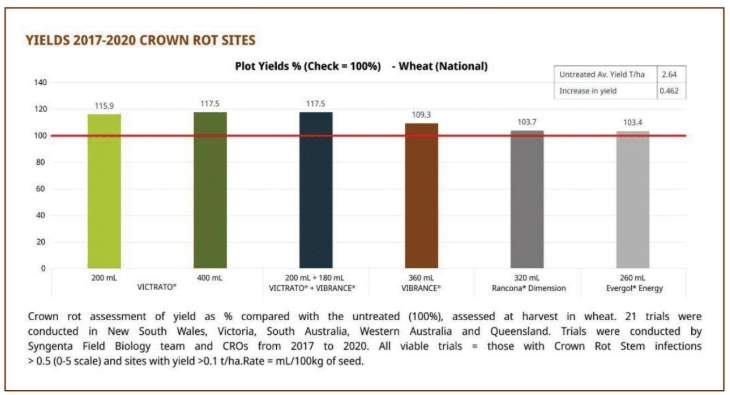A decade of Australian development has culminated in a breakthrough for wheat and barley growers, with Victrato seed treatment now registered for the management of devastating Fusarium sp. crown rot.
Since the exciting moment Syngenta field biologists first observed the results of what was then an unnamed, coded molecule, there have been more than 300 trials conducted nationally making it the company’s biggest program to date.
Crown rot is estimated to cost the Australian industry $434 million annually in lost production through reduced yield and impacts on grain quality.

Syngenta Australia general manager David Van Ryswyk says the registration will bring immediate benefits to those broadacre cropping communities most affected by the disease.
“Crown rot is a cruel disease which is often present in crops and characterised by white heads, which only become apparent once the wheat or barley reaches maturity close to harvest,” he says.
“Victrato seed treatment helps interrupt the disease lifecycle, protecting the seedling from infection as it emerges.”
Fusarium sp. inoculum, the cause of crown rot, survives in the stubble of previous crops.

When crops are grown with Victrato treated seed, Tymirium technology interrupts the energy producing mitochondria.
Without Victrato, the disease can quickly colonise the plant with mycelium growth, restricting the movement of water and nutrients to the head of the wheat and barley plants.
From outside the plant, growers and their agronomists might sometimes observe basal browning – a honey yellow-to-brown discoloration of plant stems – or whiteheads at plant maturity.
These whiteheads are indicative of hollow or pinched grains, which the plant has been unable to fill.

This can cause devastating yield losses of up to 50 per cent, while also resulting in penalties at grain receival depots due to increased screenings.
In wheat trials conducted between 2017 and 2020 (Figure1) the untreated plots averaged 2.64 tonnes per hectare, meanwhile the combination of Victrato and Vibrance seed treatment returned an average yield increase of 0.462 T/Ha.
Katie Slade, the Syngenta Australia product lead for Victrato seed treatment, says few crop protection products before it had represented such a significant development for the industry.
“Rarely as an industry do we have the opportunity to help growers drastically change the outlook for their crops on a scale like this,” she says.
This was especially the case, she says, where farmers had put crown rot in the ‘too hard’ basket, some dropping durum wheat from their program for this reason.
“There are many agronomists – too many to name here – to whom we are grateful for their support in our journey with Victrato seed treatment,” she adds.
“We are just as excited as them, to see the first batches of seed being commercially treated with Victrato now that we can begin releasing supply.”





